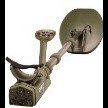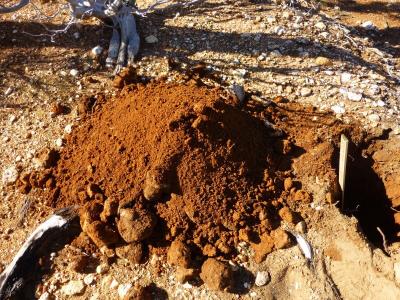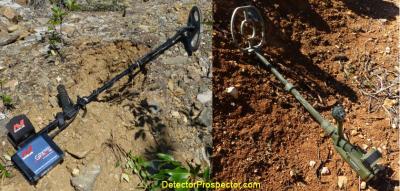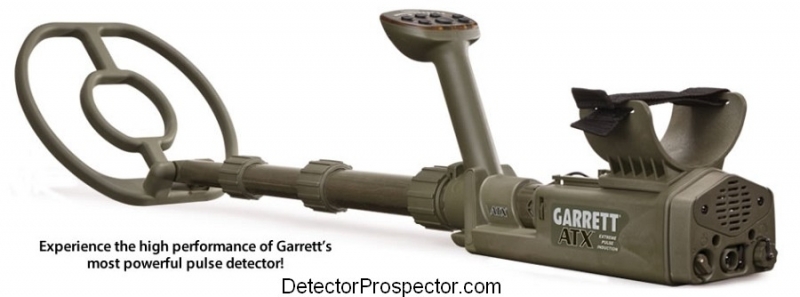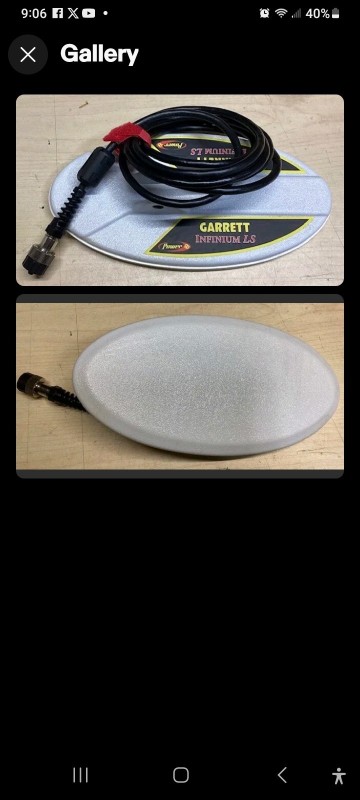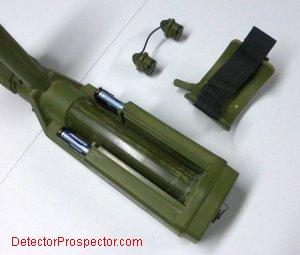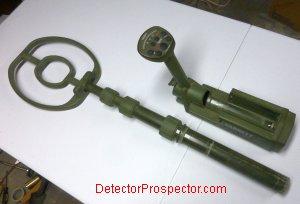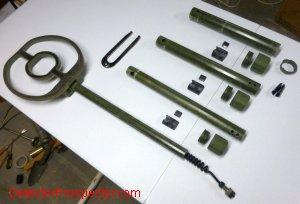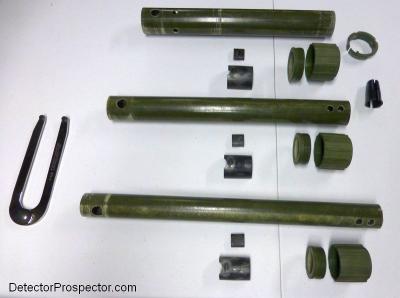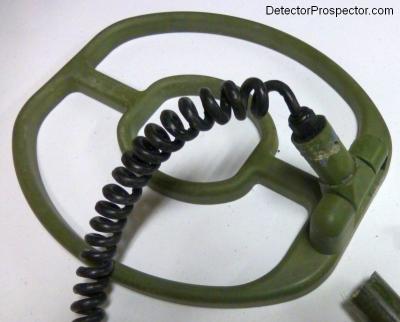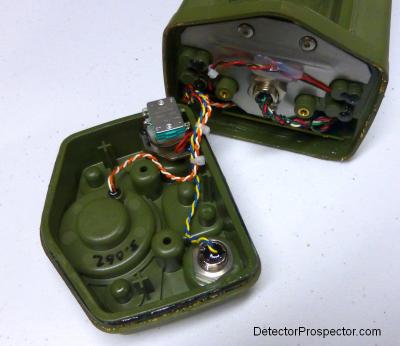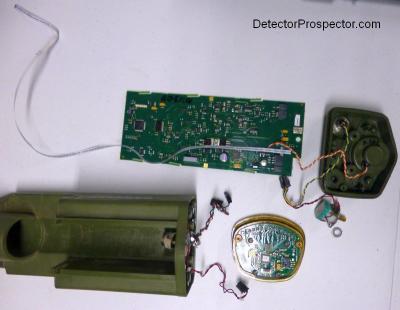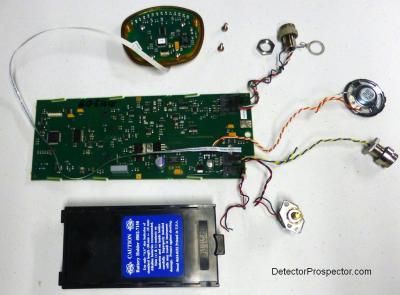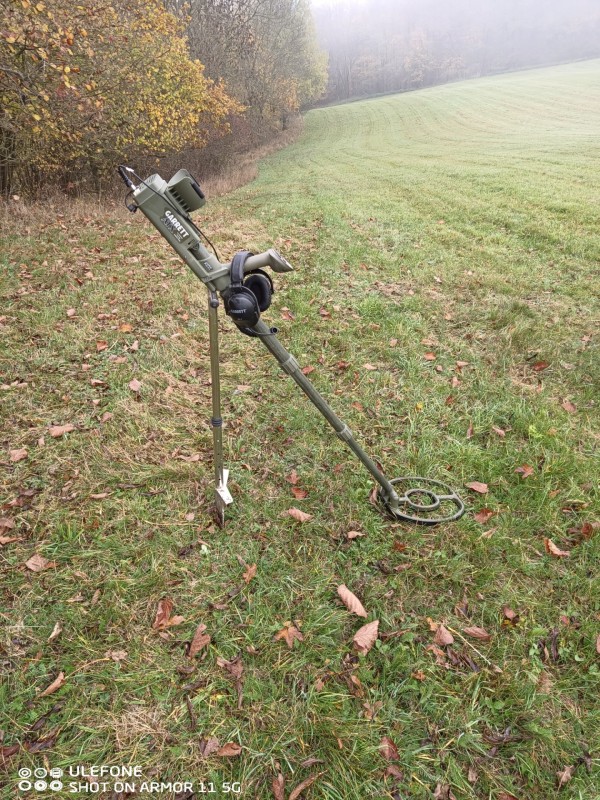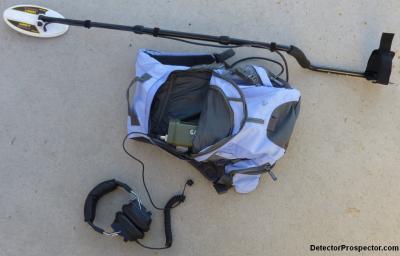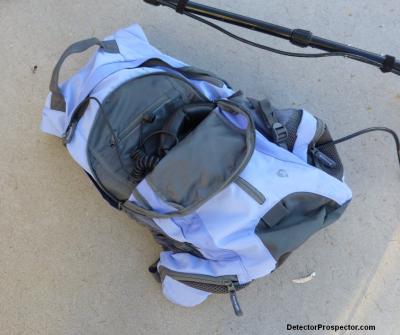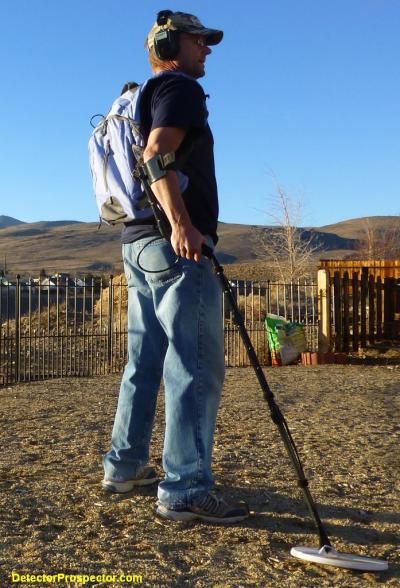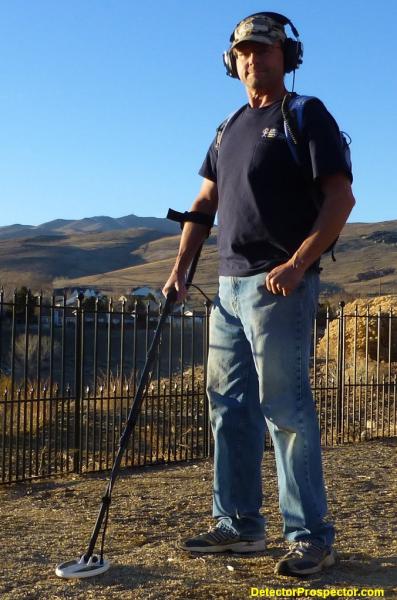Search the Community
Showing results for tags 'garrett atx'.
-
I have an 11x13 closed DD ATX coil that is defective. I have replaced it with a new one, but feel it's a shame to let a $500 coil sit useless in the corner. Is there anyone out there that could possibly modify it to be a good working , possibly more powerful coil? Just throwing this out there to see if anyone knows of an option to have this done.
-
Good day to all, I just secured a georgous authorization in a vine field, but as I started detecting this morning, my AXT began to act erratically although there are no overhead power lines or any approximate energy sources! I distanced myself to the adjacent field to see if the issue will dissipate but the problem persisted. I had no other choice than lowering the sensitivity to 0, which made me lose plenty of targets. Did anyone encountered such issue and is there a fix besides pushing the reset bottom which by the way had not made any significant difference. Thanks in advance
-
Good day everyone, firstly, I thank you for admitting me in your forum. I purchased the Garrett ATX and moved to France, this machine is super precise in detecting relics which forgives its massive weight after five or six hours of operation! Lately I discovered some difficulty in fully retracing the rods at the end of my search, and it looks that some of the black plastic tensioning shim/plate is broken between the shaft and the rods assembly. Did anyone encounter similar failure/issue? And can I still use the machine as is? I searched the web for spare parts but I couldn’t find anything. Please help, thank you
-
I consider myself fortunate to have met Garrett's Senior Design Engineer, Brent Weaver, many years ago during prototype testing of the Garrett Infinium. I think Brent deserves a great deal of credit in making Garrett the leader it is today with a series of incredible innovative bang-for-the-buck metal detectors, first and foremost being the AT series. Brent is just a real nice guy - comes across as a regular Joe not a head in the clouds engineer. I think this video shows that. It also has an extremely interesting discussion of pulse inductions detectors, ground balancing methods, and the dreaded "hole" that occurs when ground balancing. There is explanation of why the holes occur and how some designs try to alleviate but not eliminate the problem. Good stuff, starts around the 3:40 minute mark. The audio quality in this video truly sucks. However, this is important information, and so repeated listens, typing, and listening again on my part, produced the following transcript. Again, this is from Brent Weaver, Senior Design Engineer, Garrett Metal Detectors. Transcript starting at 3:40 mark: "If you look at the various pulse detectors that exist on the market, you have your simplest pulse machines, which are single pulse machines that are non-ground balancing. Those are detectors that are typically exclusively used for the beach, for example, the Sea Hunter or something like this. The next step in advancement there is to have a ground balancing pulse machine, those can still be a single pulse detector. This pulse channel is able to ground balance, which means it can neutralize the ground. The problem with that sort of technology is when you ground balance out the ground, you can also balance out any target that has a decay characteristic that is similar to the ground. We call this the "detection hole". Essentially, it is a hole in the conductivity... when you look at the conductivity of gold or any material, you look at a conductivity spectrum. The decay rate of that... pulse decay is a function of the conductivity of the material and also the thickness and shape of the material. It all factors into effective conductivity. For a ground balancing pulse detector, again, if the conductivity of the ground is similar to the conductivity of the target, when you ground balance out the ground you also ground balance out the target. To eliminate that problem, you create a second pulse which is substantially different than the first pulse, such that when you ground balance out the ground on the second pulse, its conductivity decay as far as the target is concerned, the conductivity decay on the first pulse and that on the on the second pulse do not match each other. As a result, as you ground balance out the ground on the first pulse, you create a hole, and you ground balance out the ground on the second pulse, it also creates a hole, but it is in a different location. And so, those two pulses working together in unison, working simultaneously, one will always fill in the hole of the other, they overlap such that you never have a detection hole. If you only have a single pulse detector, and it ground balances, it will have a detection hole. There are various products on the market, some are less expensive than the ATX, some are more expensive than the ATX, but if they are a single pulse detector, they are going to have a hole in their detection, period. You are going to miss gold. You are absolutely going to miss gold. Now where that hole falls depends on the mineralization conditions, and where the ground balance is set for the detector. As the ground balance shifts, the hole shifts with it. If you have a detector that has continuous ground tracking, such that you cannot switch it off, as that ground track moves around for the various ground conditions, the hole moves around with it and the targets are disappearing into that hole. You never know where the hole is at any time. Again, to eliminate that problem, the more advanced, the most advanced detectors, like the ATX, use multiple pulse technology. They don't just have one single pulse that repeats, they have different kinds of pulses, and those pairs repeat. That is one of the differences in a true high end performance product like the ATX, versus some of the other products on the market. They are good products, and they are ground balancing pulse detectors, but if they are a single pulse technology, they have a hole in their detection that will miss targets." Now, for me listening to that it is obvious that Garrett was clearly gunning for the White's TDI. How do I know that? Because it was Minelab that originally put multi period pulse detection into the consumers hands, via their MPS (multi period sensing) technology beginning with the ground breaking SD 2000. The White's TDI on the other hand is an older design, and in fact is basically just an Eric Foster Goldscan stuck in a White's labeled box. The Goldscan and the TDI are a single channel ground balancing pulse detector with the problem that Brent outlines in the video. Bruce Candy of Minelab saw the same issue, and the SD 2000 was specifically developed as a multi channel or multi period device for this very reason. MPS was patented, and so I am not sure if it was the patent expiring, or Garrett simply using a method that got around the patent, but the ATX is using a similar multi period design as the SD Minelabs. Having used the Minelabs and the TDI, plus the ATX, I can vouch for the electronics in the ATX as being very capable, and I do believe superior to that in the TDI. My ATX in fact tested favorably compared to my GPX 5000 with the 5000 having the edge, but not as much as I expected. I think in large part that is simply due to the Minelab using a much more powerful battery, pumping far more power into the ground than the ATX with its eight AA batteries. Unfortunately, in my opinion Garrett, made a huge mistake in taking these excellent electronics, and hobbling them with a housing that did not take advantage of one of Minelabs biggest weaknesses - ergonomics. The TDI had and still has a distinct edge in that regard, and at a lower price than the ATX. Ironically, it is also that detection hole and the ability to manipulate it via a manual ground balance that has become, not the big problem as laid out in this video, but a feature of sorts in favor of the TDI. People have learned how to manipulate the hole to help identify targets by using the ground balance control as a sort of reverse discrimination control. Combined with the unique conductivity switch on the TDI knowledgeable users can become very proficient at identifying various target classes, and this has made it very popular with relic hunters in particular. What history in hindsight reveals, in my opinion, is that Garrett missed the boat with the ATX as regards Minelab. The ATX hit the market before the SDC 2300, and had a window of opportunity to really make inroads, if it had been in a lighter weight dry land package, with a light dry land coil set designed specifically for desert prospecting. The electronics are there; it is the heavy housing, and heavy knock sensitive coils, overpriced by an attached telescoping rod assembly, that really hurt the machine. On the flip side, I don't think they did too much damage to the TDI either, with the TDI being a less expensive, more ergonomically friendly unit. Like the Garrett Infinium before it, the ATX has settled into being more a beach detector than a prospecting detector. I have of course been making hay over this since day one, and continue to make an issue of it at every opportunity, in hopes that we may see a Garrett LTX some day. Dry land design only for the absolute lightest weight possible machine with light weight knock resistant coils to match, it would be a winner. There is a market still I believe for a $1500 -$2000 ground balancing PI detector that clearly has more power than a TDI in an all in one package lighter than anything Minelab currently markets. The only question in my mind is whether Garrett will finally get it right, or will it finally be a moot point, when new Fisher, White's, and Nokta/Makro machines waiting in the wings finally arrive.
-
Here are a couple short videos I made before I send it in to Garrett for repair. The atx was ground balanced and frequency scanned. Sensitivity is maxed. Running smooth over unobstructed ground. In the videos you will see how knock sensitive it is. Please don't tell me this is normal for the atx. I am 100% new to pi machines, and this is the only one I've ever been around.
-
I may have a short window to add a new 8" mono coil to my garrett atx for $300. I really can't find much for review and comparison of this coil. Anyone with experience with this coil is welcome to post their experiences with it, before I blow money on something for no good reason
-
I recently posted an ATX for sale because I rarely used it and it sat in the closet most of the time, and when I did use it, it was only about an hour because of the weight. Then I saw a Steve Herschbach’s post on this site, Garrett ATX Accessories, June 30, 2018, on modification accessories for the ATX, and it was just what I needed. But, as the title of this topic states, “Almost five years too late”; I almost had to scrap the project. Steve said the only non ATX coils that would work on the ATX is the DD Infinium coils (Infinium was the precursor to the ATX) and he had a 5x10 DD on his set up. The 5x10 DD coil was discontinued in 2016 and is no longer available, I didn't want the 3x7, so that left only the 10x14. Detector companies list Infinium coils but most are out of stock and I purchased one of three coils I found ($152). I purchased an aftermarket Garrett shaft of all places on Poshmark. The shaft and coil were less than three pounds and the 3.5-pound control portion fit neatly in a 4x6x12 four compartment pouch by cutting an X on the inside of both end compartments. The coil cable ran through the end compartment by the control arm and with a chest strap faces the coil to give you extra cable for mobility when kneeling or digging. I swing the new coil/shaft setup with my left arm and operate the ATX control with my right hand. Bench testing showed improved depth with various nuggets and all controls functioned as they would with an ATX coil and very stable, as Steve had mentioned. I use an "H" harness and had 1" webbing to run up both shoulder straps and around the neck with clips to support "D" rings on the pouch, very comfortable. I bought the detector used so I wasn’t too concerned about the warranty or underwater use. I took it one step further and used an S2 tamperproof bit to remove the rear portion of the ATX to access the proprietary phone jack, scraped just enough off the speaker and jack wires to find the "common" wire (blue is common) and installed a 1/4" jack for my right-angle tip on my Nugget Buster Headphones. With the headphones plugged in you can zip up the compartment and it stays clean. The large center compartment has access to the batteries and coil connector but I leave it connected because it's too hard to disconnect and reconnect each time. Everything works great and I plan to test it in the field. I have read many posts by Steve and have learned a lot of tips and techniques that I use and really appreciate. I know there are really good new detectors out there but I have never given the ATX a real try and that is what I intend to do and for less than $200 it's like having a new PI detector. If anyone out there has a used 5x10 Infinium coil let me know. My go to detector has been the Gold Monster and I scored 1-1/2 ounces of gold in California but I'm relearning now that we are living in central Arizona. Thanks Steve.
-
(Update..problems solved) Here's why. 1. My vlf gold kruzer runs just as, or more stable in the same mineralized ground. 2. The closed DD coil is very knock sensitive. I thought that problem was resolved with the newer closed coils 3. The atx will go haywire when just setting the coil on the ground. 4. Had to run the sensitivity at 10 or lower to run smooth at all. My experience with PI machines is 2 hrs on the atx, and a ton of YouTube videos and reading articles and reviews... so I'm basically saying I don't know squat. My detecting experience in whole...it's a new passion of mine in the last couple months. I go out whenever I get a chance. My main vlf is the nokta gold kruzer. Still learning it, with about 25 to 30 hrs behind it. I'm a research junkie. Lots of reading and 100s of hrs of videos. In other words, I don't know squat. I'm hoping someone with experience with the atx will chime in with advice, and let me know if this is normal, or if I need to consider returning this machine. I appreciate any help, and or advice
-
I have used the Minelab GPX 5000 since it was introduced, and in fact probably owned the first one in Alaska. I have used the Garrett ATX also since it came out with one of the first units off the production line. I have been putting this review off while I got to know the ATX. I now have over 100 hours on the detector in a variety of environments so the time has come. This metal detector comparison review was very challenging for me to write. It pits two very different yet very similar detectors against each other. In a way it is almost like discussing three detectors instead of two, and there is the issue of a huge price difference. I apologize for the length but this is a case where I wanted to be as thorough as possible on the subject. This is the review you will never see published in a magazine! In a way it is all about that price differential. If the two detectors were priced similarly there would be much less debate than is going to occur amongst people and a far easier buying decision for some to make. For me personally it really is a story of the Garrett ATX being two very different detectors at once and so I will start the review there. I have been metal detecting over forty years now, and metal detecting is very important in my life. Not a day goes by that I do not think about, write about, or actually go out metal detecting. Luckily for me a large chunk of my income is derived from metal detecting and so I can justify a collection of metal detectors for what I do. I engage in quite a few detecting activities and I strive to have the very best detector possible at my disposal for whatever it is I am doing. Because of this I am constantly on the look for new detectors that might help me in some way. However, now that the technology is maturing I have the bases pretty well covered. The only thing I was still looking for was a detector that satisfied me while water detecting in Hawaii. Every other detecting scenario I have covered to my satisfaction, but every time I hit the water in Hawaii I was left wanting something better than was available. The combination of salt water, volcanic rock, and military grade electrical interference is very challenging for any detector. What I generally want is a combination of stability and power with good ergonomics. The perfect detector should only signal on desired targets and nothing else, at good depth, while feeling good on my arm. I obviously reject detectors that get poor depth - these are usually the lower price detectors. Most top tier models are very competitive in the depth department. Other detectors I have put aside solely due to an inability to handle electrical interference. Fine machines otherwise, but unstable in an urban environment. Other detectors are too noisy in mineralized ground or too chatty in dense trash. And finally, some detectors are holdovers from the old days of heavy and clunky. I do not like detectors that make my arm hurt! I was therefore very excited when I heard the Garrett ATX was on the way. I was very familiar with its predecessor, the Garrett Infinium, which was tantalizingly close to my perfect Hawaii detector. Unfortunately the Infinium suffered in the stability department. I was also aware of the Garrett Recon Pro AML-1000 military demining detector. I was intrigued by its having a non-motion monotone search mode and wondered if that could be incorporated into a new improved "Infinium Pro" model. I not only had Hawaii in mind but started envisioning scenarios involving underwater sniping for gold employing a metal detector. Add to this that neither Minelab nor White's seemed interested in putting a waterproof ground balancing pulse induction metal detector in my hands. I never expected it would be Garrett that would come out with a second generation model based on the Infinium before anyone else got to first base. I have told you all this to explain what I was expecting and hoping for in the Garrett ATX. The fact is Garrett delivered with flying colors on my desires and the ATX is now one if the most important detectors in my collection. I have already paid for the detector with jewelry found and it is the Hawaii detector I always hoped for. Garrett ATX in Hawaii If we are talking about the Garrett ATX as a new waterproof detector for use on black sand or volcanic island beaches the review can end right here. The Garrett ATX is a superb detector for those conditions and well worth the money. There is only one fly in the ointment. If you look at the full page ads for the Garrett ATX it is clearly being marketed as a prospecting detector, and one pretty clearly aimed at Minelab's top end models. Specifically "The ATX performs head-to-head with the most expensive prospecting detectors in the world." ads by Amazon... Interestingly enough this idea was not even on my radar. I had always thought it was a huge mistake for the Infinium to be set up as direct competition for the high end Minelabs. Anyone involved in that remembers the hype and resulting disappointment and backlash. The Infinium eventually found its place but more as a water and relic hunting machine than a prospecting detector, although it is a capable enough unit. My hope was to avoid a similar scenario with the ATX. I do not like hype and prefer things to be under sold so people are pleasantly surprised when their expectations are exceeded. Hype leads to disappointment when inflated claims cannot be met. The reality here however is that Garrett has chosen to make prospecting the battlefield of choice. There is a lot of money at stake here for a lot of people, and so I am going to do my best here to compare the two units as dry land prospecting detectors. I think we can all agree that if you are looking at both the Garrett ATX and Minelab GPX 5000 and need the detector to be waterproof the Garrett ATX wins hands down. The funny thing here is that if Garrett was gunning for Minelab then in my opinion they went about it the wrong way. I get the distinct impression the design process was backwards. It was not a matter of "what do prospectors want in a metal detector?" I think it was "we have this housing on the shelf we developed at great expense to go after a military contract. We need to leverage our development cost by putting something in that housing we can sell to the public." In other words, I do not see any sign of design following function. All I see is a prospecting detector crammed in a box inappropriate for the desired end use. If Steve Jobs was into metal detectors he would be rolling in his grave. I will have to suffice instead by simply shaking my head at missed opportunity. I will explain more about that later. Let's set ergonomics aside though for now and just talk about straight up prospecting performance. How does the Garrett ATX fare against the Minelab GPX 5000 on gold in mineralized ground? I have done fairly extensive tests but I do have to throw in the caveat that the world is a big place and when you discuss prospecting detectors one truth is paramount. It is all about the ground mineralization and hot rocks. What works well in one place fails in another, and for this reason alone I cannot offer 100% assurances. I have spent a month traveling Western Australia detecting every day and so I am quite familiar with what prospectors face there. I am not about to begin to offer more than an opinion about how these two detectors fare in the worst Australian ground but I do think my conclusions will prove to be true. I can tell anyone right now knowing detectors the way I do that either machine will prove superior at certain locations given their differing capabilities. In a nutshell, the Garrett ATX has a ridiculously good circuit. The engineers at Garrett have done a superb job of producing a detector that out of box performs extremely well on a wide variety of gold in a wide variety of ground conditions. I tested both units in some very red mineralized soil, both outfitted with stock DD coils. The ATX comes with a 12" x 10" DD coil. The GPX 5000 comes with two coils, one of which is an 11" round DD coil and this is what I used. The nuggets ranged from 0.1 gram to 6.5 ounces. Test conditions The impression I was left with was definitely not how the GPX 5000 blows the ATX away but instead by how well the Garrett ATX does. It is impossible to not be impressed by how well the $2120 detector does when run head-to-head against a $5795 detector. Garrett has done a fantastic job and in my opinion their advertising claims are not off base. This is a serious prospecting circuit well worth consideration. The two detectors basically differ in the range of gold they find best. The Garrett ATX skews towards the smaller more commonly found gold nuggets. The Minelab GPX 5000 skews towards larger gold nuggets that tend to be the goal of professional prospectors. Out of box with similar coils the ATX will find small gold nuggets the GPX 5000 would normally miss without special coils and tuning tricks. It does this simply and with no fuss. However, in mineralized ground with similar coils the GPX easily bests the ATX on large nuggets. By large I mean one ounce and larger and by easily I mean by a margin of 10-15%. The GPX 5000 does this using a coil that in my case had never been on the detector before. Most Minelab users would never consider hobbling the detector by putting the 11" round DD coil on if hunting large nuggets at depth. It is informative therefore that even doing this in the interest of "fairness" and with nothing more than stock Normal timing with Gain bumped to 16 (out of 20) the Minelab GPX 5000 easily outperformed the Garrett ATX on a 6.5 ounce nugget. The ATX was at max Gain of 13 for the test. Now the depth differential here was only about two inches but I have to throw in the huge caution note again that it will vary depending on ground conditions. Absolute depth was about 17" ATX versus 19" GPX for good solid signals. The kind nobody can miss. Again, do not take these as some sort of magical numbers as ground conditions and even nugget shape and alloy could cause you to get some surprising differences. That is why I hate mentioning exact depths and differences in most cases and just stick to relative conclusions. But you are going to ask so there you go. For reference a Fisher Gold Bug Pro with 13" round DD coil and White's GMT with 14" elliptical DD both with settings jacked to the max were barely able to obtain this solid gold 6.5 ounce nugget at 12" in this ground and the GMT in particular would not really have been able to hunt maxed out the way it was. Depending on who is reading this the response may be "really, only two inches?" or "wow, two whole inches!" Similarly, it is interesting to see the GPX with DD coil scrub a little nugget with no signal that the ATX easily detects at a couple inches. This however does end up being my basic and not new finding by any means. Others have reported similar results. The ATX does better on small gold and the GPX on large straight out of box with stock DD coils. I do believe the GPX has more ability to handle more varied and more intense ground conditions and hot rocks due to its many adjustments. However, this is more a belief than a fact as so far the ATX has easily handled everything I have thrown at it, including salt water, basalt rocks, and electrical interference in Hawaii. Garrett does make use of a salient fact in its advertising. The ATX handles a wide range of conditions with deceptively few settings. This makes it very easy to set up and it avoids a common complaint with the GPX detectors. They are so complex people are often left wondering if they have the optimum settings for the conditions. I know for a fact from observation that many people tend to use timings that are too aggressive for the actual conditions when using a GPX. The tendency often is to find something that seems to work well and then to just default to that way if doing things, even if conditions change. To get the best performance out of a GPX does require that a person be somewhat of a tuning wizard. The bottom line for many more casual prospectors in the United States especially is that the Garrett ATX represents a fantastic value. It is truly impossible to say but in my case at least most of the gold I find in the US with my GPX an ATX would have found it also. In particular when hunting areas where bedrock is a foot or less the ground would have to be extremely hot indeed for the ATX to not only find what the GPX will but to have an edge on the more common small gold. Even in deeper ground as long as the gold is measured in grams and not ounces and the ground not extremely mineralized the ATX is going to be a close match with the GPX. Again, out of box with stock DD coils. Where the ATX is going to clearly come up short is on large nuggets, especially those sought after 1 ounce and larger nuggets at depth and on gold in the worst mineralized ground and hot rock locations. To be perfectly honest I feel my putting an 11" inch round DD coil on my GPX 5000 in the interest of being fair does not reflect for one second how I look for gold. I am not out there being fair, I am out there looking for gold. I will be running a larger mono coil with settings optimized for larger gold and then the difference in large gold performance between the ATX and GPX is even more pronounced. I would consider a 10-15% to be a bare minimum advantage gained while in effect running the GPX with its hands tied. I have not done comparisons on the iron discrimination systems but I find the method used by the ATX to be inherently more reassuring. The GPX reacts to shallow ferrous targets by blanking out, a sort of non response. The ATX has a momentary ferrous check that kicks in at the touch of a button, and that gives a low tone growl on iron, which provides a more nuanced and natural response expected by most detector users. I am not a big fan of using discrimination on either unit but I did find the ATX method more to my liking for confirming shallow ferrous stuff as trash that I already thought was trash due to the response. Note that on either detector the ferrous rejection only works on shallow items and only with a DD coil. The amount of rejection is adjustable on the GPX and preset on the ATX so more tests really need to be done in this regard to determine which is the more accurate and useful system. Minelab GPX 5000 and Garrett ATX (Minelab outfitted with optional Nugget Finder coil) I do own both detectors and there is a simple reality here. If I am going looking for gold in the water, be it jewelry or nuggets in a creek, I will grab the ATX. For any other prospecting, the vast majority of it, I will be using the GPX 5000. I am not sure where the line between casual and serious is, but I am way, way over on the serious side. I spend a great deal of time targeting and hunting deep ground looking in areas where very large nuggets have been found historically. Most of the ground I detect I am hunting because it has produced nuggets weighing a pound or more in the past. I hunt tailing piles a lot so bedrock is tens of feet down, and the gold can be at any depth from shallow to extremely deep. I think most professionals would tell you that small gold is what happens along the way while looking for the big stuff, and at the end of the day it is the big stuff or the lack of it that makes the difference. I found over thirteen ounces of nuggets metal detecting in 2013 which is no great sum of gold in my book, but well over half of it was in the form of two nuggets, one weighing 6.5 ounces and the other 2.37 ounces. Now in this case the ATX would have found both these nuggets. Yet I would not use anything but a Minelab GPX for what I am doing. I am spending a lot of valuable time going over ground that I may only get one shot at. I plan these things well in advance and not only time but good money is invested in taking my best shot at getting good results. I basically cannot afford to be running anything that I feel does not give me the best chance of delivering that make or break it big nugget. One nugget can make all the difference between a month of lackluster results and fantastic success. If both the Garrett ATX and Minelab GPX 5000 detectors had exactly identical electronic performance I would still be swinging the GPX. I am on one hand very impressed with the ATX as a nugget detector and on the other hand very disappointed by it. The up front decision to use the Recon AML-1000 housing is an automatic fail from a nugget detecting perspective in my opinion. It adds not only needless weight but weight that is very much an impediment in rough, uneven terrain. This is accentuated by a stock coil that is sensitive to knocks and bumps. It requires an extra level of coil control to manipulate the detector in such a way as to not produce excessive false signals. This differs from Minelab coils that basically do not false at all unless something is wrong with them. I would caution anyone using a detector the way I do that the ATX requires extra care as regards the possibility of repetitive motion injury. Trust me as somebody who detected too much one year and ignored the signs this is something to regard seriously. A harness is a must for weeks of long daily use of the ATX. I shudder to think about how the detector feels with the 20" long rear mounted mono coil hanging off the front. That is an ergonomic nightmare. The ATX features silicone lubricated battery door o-rings that collect dirt. The coil connectors also have o-ring seals and even worse delicate pin connectors subject to damage if not carefully lined up. The headphone connector is similar to the coil connectors. All these are required to make the detector waterproof and not only unneeded for normal dry land use but an impediment as regards serviceability in the field. The coils are sold as a unit with the telescoping rod assembly adding needless expense and weight and making carrying an extra coil around something to be avoided. The rear mount enables the ability of the detector to fold up but is another weak point from a serviceability aspect and ergonomically the worst way to mount a coil. I always considered ergonomics to be the easy low hanging fruit for anyone considering manufacture of a detector to compete with the Minelab PI series, and I am frankly amazed anyone could make something even heavier I am less excited about handling. It is an absolute fact I would put the GPX aside for an alternative, even if that alternative was next best in overall gold ability, if it offered a big advantage ergonomically. I in fact often do decline to "harness up" and set the GPX aside in favor of a lightweight VLF at times because I am just too tired or not in the mood. More importantly, in steep terrain bedrock is often shallow and so when hunting hillsides and slopes there really is no advantage to using a GPX in ground only inches deep. I would very gladly use a properly designed Garrett ATX instead of a Minelab GPX in many situations that I currently encounter. In particular areas where bedrock is less than a foot deep or in areas where large nuggets have historically never been seen. The only reason right now that is not going to happen is I do not want the ATX on my arm. Yes, the ATX has an inherent advantage on small gold but nothing I can't negate by putting on a small mono coil and running the GPX hot. No, in my opinion Garrett missed a major opportunity to wow somebody like me by putting a fantastic prospecting circuit in a package very inappropriate for the target audience. Metal detectors are tools. Now the fact is that for the average person Craftsman tools do just fine and represent good value. But the guy making his living with his toolbox is probably going to be investing in Snap-on tools. It is an apt analogy accentuated by the real performance difference that exists between the Garrett ATX and Minelab GPX detectors on the kind of gold most pros are looking for. The vast number of accessory coils and other aftermarket options on top of a well proven platform makes it an easy decision for the serious prospector. Minelab makes a tool designed specifically for a certain job. The Garrett ATX unfortunately I feel is a duck out of water when employed for normal prospecting uses. I do have to say my hat is off to Garrett for producing a detector that is the first to really give Minelab a run for the money. I hope they do follow up and produce a model expressly designed from the ground up as a dry land prospecting machine. It may well become my primary prospecting detector if they do so. If you have read this review carefully you should understand the issues involved. For many people wanting maximum bang for the buck a Garrett ATX straight up and used properly is a real bargain in a PI prospecting machine. It can and will find gold and find it very well. The guys like me (you know who you are) that probably already have a Minelab PI plus extra coils, batteries and so forth can continue waiting for the next big thing in nugget detecting. You may also consider the Garrett for exactly the reason I did. It is waterproof, and currently is the closest thing you can get to a Minelab PI in a waterproof package. In closing I am curious to see how both detectors do for me this year. The ATX has the lead with about 2.5 ounces of gold and platinum jewelry found so far. I plan on using it often to hunt jewelry every chance I get in 2014. The GPX I will once again be taking to Alaska for a couple months of nugget detecting which may or may not pay off with a large nugget found. I will be hunting the right places but large gold is rare almost anywhere you go. Given the lead the ATX already has the GPX has its work cut out for it so it should make for an interesting year. For those of you trying to decide between these two very fine metal detectors I can only sympathize and count my blessings for not having to make such decisions. However, I hope this helps you with your decision because I have done my best to try and do just that. Good luck and good hunting! 2020 Note: Since this review was written in 2014 the price for the ATX was remained the same, while the price for the Minelab GPX 4500 and GPX 5000 have both come down considerably. This does change the value proposition offered by the Garrett ATX, especially as regards the Minelab GPX 4500, which can now be had for only a few hundred dollars more than an ATX. Detailed information on the Garrett ATX Detailed information on the Minelab GPX 5000 Great video by another party (a Garrett dealer) confirming the above results at another location with a different large nugget....
-
I just ordered a Garrett atx deepseeker package for $1300. It has the larger deepseeker coil, and the standard "closed" dd coil. Then I ordered a new, open box infinium 5x10 dd sniper coil for $75. So for just under $1500 (with taxes, and shipping) I think I will have a good first PI machine geared toward nugget shooting. I'm a professional lead detectorist already, so how hard can gold be? ? looking forward to all opinions and constructive criticism.
-
I'm planning on my yearly trip to the Florida Treasure Coast in November and in the past have been using my Orx and Nox. This year I'd like to try something different in the way of a PI so I'm considering buying the ATX or Axiom. Curious to know if others have used either one between Melbourne and Fort Pierce. I'm thinking the ATX would be more robust to the elements. Thanks.
-
The Garrett ATX price point keeps bringing me back for another look as opposed to the Minelab SDC and the Axiom. I have been looking at the 11x13 closed mono coil for the edge sensitivity in addition to ground coverage. If I can avoid it, I don’t want to purchased a DD coil plus the 8” mono coil. However, it is not a given that the coil will not be submersed under water. I realize the 10x12 has a center sweet spot that does not fit into tight areas. Has anyone used the Garrett ATX with the 11x13 closed mono coil? How does the 11x13 closed mono compared to the 10x12 opened DD with a full scuff cover plate?
-
Well, coffee and tools in hand I got going with the fun part - taking stuff apart! Many photos in this thread will enlarge if you click on them. You can probably see where I am going with this. Circuit board in a box with single AA battery holder and control panel tacked outside with controls. All in one box that can be rod mounted or hip or chest mounted. If rod mounted, I want to be able to use stock DD coil, or Infinium 5" x 10" DD and 4" x 7" DD. Not willing to pop for another ATX 8" mono at this time as the one I have stays as it is to use with the other ATX I will be getting. We will see how this works out first. In theory I would like to do a real professional box with drop in battery, just like a White's TDI SL but the box would have to be longer. I may however go cruder than that, more like a Surf PI with a lid I need to open to replace batteries. Be nice to use rechargeables and rig to just plug detector in to charge it but again, I may not want to work that hard at it. Paul would do a bang up professional job. I am all about expediency myself. If anybody want to see a closeup of anything or has any questions about how this thing comes apart ask away. I know I had to go buy yet another stupid tool to remove the Torx security screws!
-
Many of you may have already viewed this video by the The Hoover Boys detecting an old picnic area with the Garrett ATX. If I recall correctly Garrett released the ATX in 2013 then added the 11x13 closed coils around 2017-18. Per one of the 842 comments of this three year old video they are detecting with both the original 10x12 DD open coil and the 11x13 closed DD. There are also a few videos on YouTube that addressed the ATX ability to handle EMI with both the DD & mono coils. In this video The Hoover Boys refer to the Garrett ATX as a nickel machine and as “the brick”.
-
Other than the weight and cost of coils, has anyone compared the ATX to the Axiom for prospecting?
-
I did a bit of Google searching for posts in the last year to see if I could get a feel for how much use the Garrett ATX gets and what people are finding with it. Not much to see though. The Garrett Australia Facebook page has some gold nugget finds https://www.facebook.com/GarrettAustralia/ The Findmall ATX Forum would have you thinking the ATX is strictly a beach detector Link deleted since Findmall Forum update broke all old links and other than that a few relic hunters out there using it. The ATX is one of my favorite detectors and quite a capable nugget detector, but after some early nugget detecting it now only gets used seriously as a beach and water detector. The problem is with ATX at $2120 and 6.9 lbs, limited coil selection, it is a tough machine to recommend for prospecting with a Minelab GPX 4500 running only $2699 at this time. I still consider the ATX to have been a missed opportunity. At $1699 in a lighter weight dry land package and sporting less expensive dry land coils the machine could have made a real impact on the prospecting world. Instead it is a rare sight on the goldfields.
-
Specifications for the Garrett ATX list the total weight for either the 10x12 (open) search coil or the 11x13 (closed) search coil as 6.9 pounds. The 10x12 weighting 3 lbs 7 oz and the 11x13 at 3 lbs 7.5 oz. Does anyone know the total weight of the ATX with the 8 inch mono coil?
-
Hi friends from US! While doing my deep research on atx, to really understand how this technology works. I struggled to identificaing targets based on audio tones. Yes, I know that Pi machine has poor ability for recognition targets. But while motion mode provides dual tone audio feedback, I keep wondering about message that provides me. That scale of tones may varying from hi/low to low/hi and that is my question. If tone starts with very short low tone with long hi tone echo, what I can predict about target material? And otherwise. If target get you short hi tone followed by long low echo, may I assume that the long echo tone assigning the target to the scale of material corresponding to the tone? So if I get short low tone followed by long hi echo, target response should be somewhere close to low conductive material? Even if the complete audio response is low/hi indicating good conductor? Is there any advice how I can be better in recognition targets based only on audio response, beside to dig everything what Iron check doesnt recognize? How the iron check actually works? Can I use it to helping identificaing targets, even if they are not iron. I have noticed that if I swing over for example pulltab in Iron check mode, it does not make any difference(off course it did not), but when the audio is non existent in Iron check, what that can tell me? Before You ask why I decide for atx ( If you dont know Iam a begginer) I am also motorcycle enthusiastic and my condition for packing are limited, so this is numero uno for me, and offcourse the military housing just ring a bell for me. Thank you for your time. Greetings René
-
Hello everybody. Any of you have ever done a Garrett Atx coil cable extension?I have an infinium coil and I put the unit behind my back into a bag.It's very light to use but I like the standard 10*12 Atx coil! Maybe this coil cable extension submersible in water? Thanks so much
-
Has anyone ever tried to put a carbon fiber shaft on the Garrett ATX?
-
Has anyone had an issue with the coil bolt end coming off? Where would I get a new coil bolt?
-
Hi guys, I'm from Argentina. I detect in the Andes mountain range, bordering Chile, I currently have an XP ORX elliptical coil, I got a lot of superficial gold up to 15-20 cm, but I want to go a little deeper, I don't have extreme mineralization, it's intermediate and maybe some hot rocks. Returning to the subject, there are not many options for pi detectors here in Argentina, minelab with astronomical prices, garrett atx and some other used TDI. no minelab used here, only new gpx 6000 and gpz7000 available. if i choose the garrett atx will i gain depth compared to the xp orx with elliptical coil? or is it preferable to acquire a 9" hf coil and continue playing with VLF?
-
Hi, I determined that Garrett Infinium DD (not mono) coils work with the Garrett ATX. That opened the door for some kind of hip or chest mount. But the control box is large enough and with the handle sticking out not really working out the way I wanted in that regard. A nice thing about the ATX is it retains all settings when switched off. So in any location it is just set and forget. The headphones have adjustable volume controls. I went with backpack mount. I got a cheap but surprisingly nice backpack at Walmart for $20 that was the right size with extra pockets and well padded. I put the control box in nose first and punched a small hole in one lower corner pocket for the coil cable to enter the backpack. The cable comes around under my right arm. The headphones just route out top of the backpack zipper and to my left side. The headphones tuck into an exterior pocket for packing around and I could break the rod assembly down and stow it also if need be. The rods would stick out of the top of the backpack a bit but in reality I would just leave it assembled unless shipping. The only thing I want to do now is use the headphone adapter dongle to rig an external speaker on one backpack strap near my ear like I do with my Minelab. Kinda crazy doing this but bottom line is it is sweet. I hope to get out in a few days and give the new setup with 10" x 5" DD coil a spin prospecting. I ran the rig for two hours in a tot lot and it was great. Very sensitive to tiny targets. The coil does not false when knocked about like the stock ATX coil. Should be an excellent prospecting setup for rough terrain. Coil and rod part numbers at https://www.detectorprospector.com/magazine/steves-reviews/garrett-atx-metal-detector-accessories/
-
Consider myself pretty handy, a question for anyone. I would like to repair an ATX 12in dd with the typical cracked up coil wire, looking for info on replacement coiled wire and a new connector plug . If none are available then what would be the proper straight cable to use to connect it without the capability to retract it? Just for a “see if I can fix it” project. Thx for any info, Jerseybones

